- Home
- About Us
- Industry
- Services
- Reading
- Contact Us
Vehicle for Disabled Market: Current Analysis and Forecast (2024-2032)
Emphasis on By Vehicle Type (Passenger Car, MPV/SUV, Pickup, Mobility Scooter); By Manufacturer Type (OEM, Aftermarket), By Driving Option (Swivel Seat, Driving Through Wheelchair, Driving on Normal Seat), and Regions (North America (The US, Canada, Rest of North America), Europe (Germany, The UK, France, Italy, Spain, Rest of the Europe), Asia-pacific (China, Japan, India, Rest of the Asia-pacific), Rest of the World)
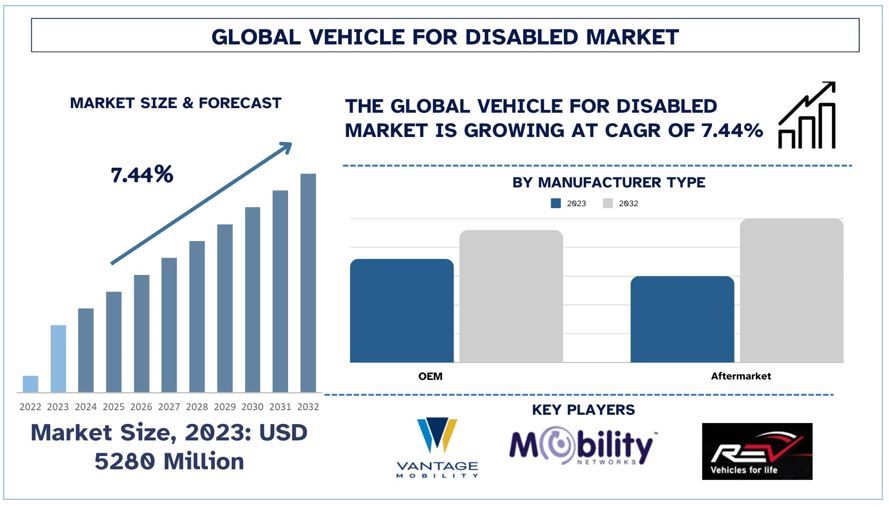
Global Vehicle for Disabled Market Size & Forecast
The Global Vehicle for Disabled market was valued at USD 5280 million in 2023 and is expected to grow at a strong CAGR of around 7.44% during the forecast period (2024-2032) owing to rising demand for mobility options for people with disability across the globe.
Global Vehicle for Disabled Market Analysis
Global Vehicle for Disabled market has witnessed a stable growth in the historical years. Vehicle for disabled are used for commuting disabled people with certain mobility issue and require specialized equipment which can be accommodated into the vehicles and help it for easy ingress, egress and driving of the vehicles. Additionally, this type of vehicle is more focused towards people with some disability, aging people as well as people suffering from any temporary ailment. Considering the targeted customers the vehicles are integrated with smart technologies which would help easy usage and ease the mobility of the people.
The Global Vehicle for Disabled market was valued at USD 5280 million in 2023 and is expected to grow at a strong CAGR of around 7.44% during the forecast period (2024-2032). One of the key factors that has attributed to the rising demand for the vehicle for disables is higher number of automotive companies progressing in the domain with their new-age vehicle equipped with the facility to be used by disabled customers. With the growing number of options for the same the available choices would also increase and help build a robust demand for vehicles for disabled. For instance, in 2023, Toyota Mobility announced to launch its inclusive electric vehicle at Paris Olympics 2024. According to Toyota it believes in inclusivity due to which it has used its vehicles designed with last-mile service and transport for the people with accessibility needs.
Considering the upsurge in the demand for vehicle options with ease of commute for people with disability the demand for Vehicle for Disabled would also increase in the forthcoming years. Additionally, many of the governments across the globe has focused on the adoption of vehicles for disabled and provided various tax rebates, subsidies, etc., which would reduce the cost and help the buyers to opt for such vehicles.
Considering all the changes such as the government support is further anticipated to rise further promoting the demand for the Vehicle for Disabled during 2024-2032.
Global Vehicle for Disabled Market Trends
This section discusses the key market trends that are influencing the various segments of the Global Vehicle for Disabled Market as identified by our team of research experts.
Integration of Assistive Technologies
Many of the assistive features which are integrated in the vehicles are becoming key trend further supporting the easier usage of vehicles for the disabled across the various geographies. These technologies include enhanced accessibility features as automated wheelchairs, ramps, hand controls, Advanced driver assistance systems, customization controls of vehicles, etc. Integration of smart technologies as Internet of Things (IoT), connected car systems, voice commands and various other smart application are further anticipated to make the usage of vehicles easier for the people with disabilities. Considering all the shifts the integration of assistive technologies in the vehicles would be a crucial factor which would help ease the usage of vehicle and help build a robust demand for the vehicle for disabled market during 2024-2032.
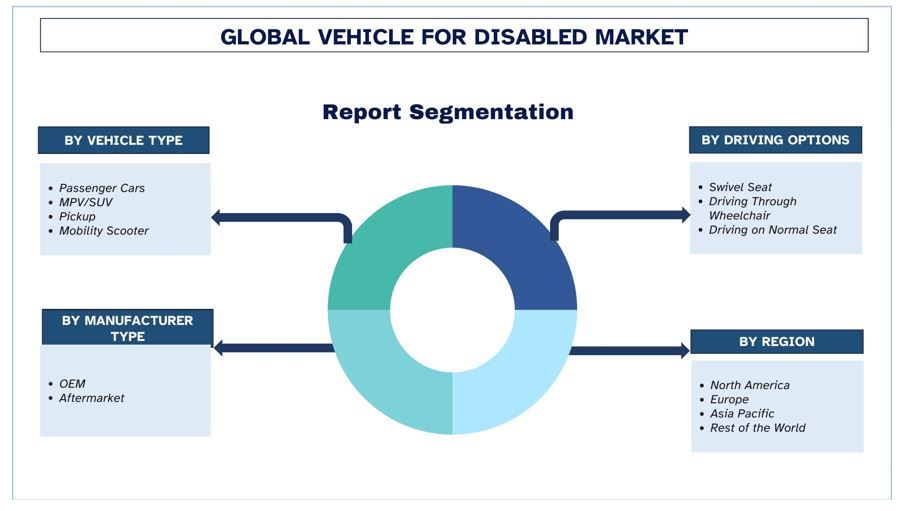
Asia Pacific is Expected to Hold Major Market Share During Forecast Period
Asia Pacific region has held a significant market share in the global Vehicle for Disabled market in 2023. Some of the factors attributing to the growth are automotive companies aligning their efforts towards offering more number of options of vehicles for disabled. These new options among the vehicle for disabled would help create a robust demand. For instance, in 2021, Hyundai Motor India Limited organized Samarth Assistive Devices Conclave. In this event Hyundai distributed 72 advanced assistive devices to people with disabilities.
The governments in the region have also announced their plans to provide subsidies to the people with disabilities to ease the adoption of vehicles. For instance, in 2019, the Ministry of Finance India announced to provide concessions on the Goods and Service Tax to the person with disability.
Considering all the shifts the demand for Vehicle for Disabled would further grow during 2024-2032.
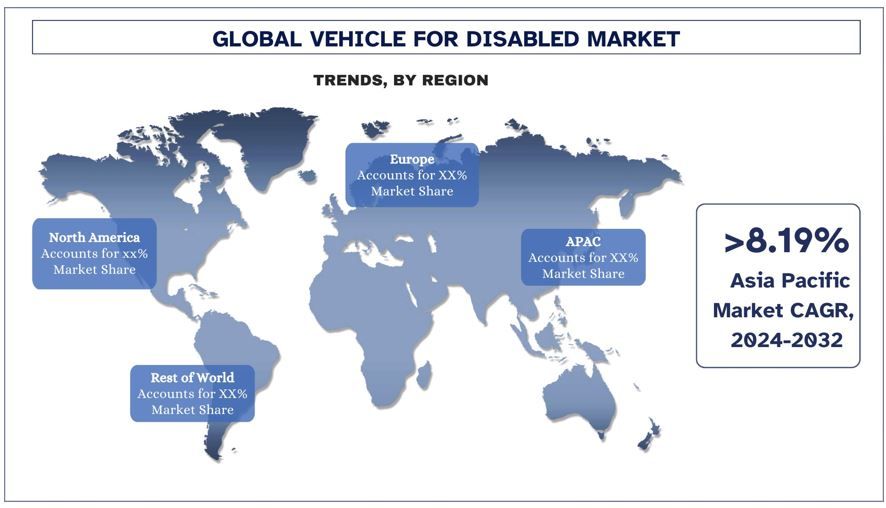
Global Vehicle for Disabled Industry Overview
The Global Vehicle for Disabled market is competitive and fragmented, with the presence of several global and international market players. The key players are adopting different growth strategies to enhance their market presence, such as partnerships, agreements, collaborations, new product launches, geographical expansions, and mergers and acquisitions. Some of the major players operating in the market are Pride Mobility, Toyota Mobility, Tga Mobility, Hoveround Corporation, Rev Group Mobility, AMS Vans, Mobility Networks (Holdings), Lewis Reed (WAV) Ltd, Vantage Mobility LLC, and Electric Mobility Euro Ltd.
Global Vehicle for Disabled Market News
- In 2024, Avvenire an electric mobility company announced to introduce Tectus AWD all-season mobility scooter for the aging population. According to the company aging population require year round mobility solutions which the company is focusing to cater.
- In 2021, Komaki, India based EV venture announced to launch XGT X5-e scooter for elderly and persons with disabled.
Vehicle for Disabled Market Report Coverage
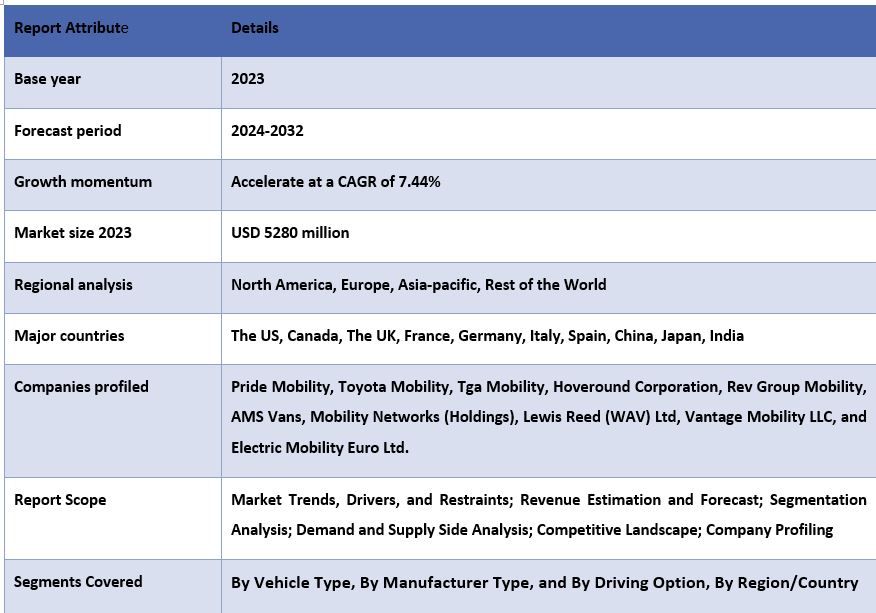
Reasons to buy this report:
- The study includes market sizing and forecasting analysis validated by authenticated key industry experts.
- The report presents a quick review of overall industry performance at one glance.
- The report covers an in-depth analysis of prominent industry peers with a primary focus on key business financials, product portfolios, expansion strategies, and recent developments.
- Detailed examination of drivers, restraints, key trends, and opportunities prevailing in the industry.
- The study comprehensively covers the market across different segments.
- Deep dive regional level analysis of the industry.
Customization Options:
The Global Vehicle for Disabled market can further be customized as per the requirement or any other market segment. Besides this, UMI understands that you may have your own business needs; hence, feel free to connect with us to get a report that completely suits your requirements.
Table of Content
Research Methodology for the Global Vehicle for Disabled Market Analysis (2024-2032)
Analyzing the historical market, estimating the current market, and forecasting the future market of the Global Vehicle for Disabled market were the three major steps undertaken to create and analyze the adoption of Global Vehicle for Disabled in major regions globally. Exhaustive secondary research was conducted to collect the historical market numbers and estimate the current market size. Secondly, to validate these insights, numerous findings and assumptions were taken into consideration. Moreover, exhaustive primary interviews were also conducted with industry experts across the value chain of the Global Vehicle for Disabled market. Post assumption and validation of market numbers through primary interviews, we employed a top-down/bottom-up approach to forecasting the complete market size. Thereafter, market breakdown and data triangulation methods were adopted to estimate and analyze the market size of segments and sub-segments of the industry. Detailed methodology is explained below:
Analysis of Historical Market Size
Step 1: In-Depth Study of Secondary Sources:
A detailed secondary study was conducted to obtain the historical market size of the Global Vehicle for Disabled market through company internal sources such as annual reports & financial statements, performance presentations, press releases, etc., and external sources including journals, news & articles, government publications, competitor publications, sector reports, third-party database, and other credible publications.
Step 2: Market Segmentation:
After obtaining the historical market size of the Global Vehicle for Disabled market, we conducted a detailed secondary analysis to gather historical market insights and share for different segments & sub-segments for major regions. Major segments are included in the report as by Vehicle Type, Manufacturer Type, and by Driving Option. Further regional/country-level analyses were conducted to evaluate the overall adoption of testing models in that region.
Step 3: Factor Analysis:
After acquiring the historical market size of different segments and sub-segments, we conducted a detailed factor analysis to estimate the current market size of the Global Vehicle for Disabled market. Further, we conducted factor analysis using dependent and independent variables such as by Vehicle Type, Manufacturer Type, and by Driving Option in the Global Vehicle for Disabled market. A thorough analysis was conducted for demand and supply-side scenarios considering top partnerships, mergers and acquisitions, business expansion, and product launches in the Global Vehicle for Disabled market sector across the globe.
Current Market Size Estimate & Forecast
Current Market Sizing: Based on actionable insights from the above 3 steps, we arrived at the current market size, key players in the Global Vehicle for Disabled market, and market shares of the segments. All the required percentage shares split and market breakdowns were determined using the above-mentioned secondary approach and verified through primary interviews.
Estimation & Forecasting: For market estimation and forecast, weights were assigned to different factors, including drivers & trends, restraints, and opportunities available for the stakeholders. After analyzing these factors, relevant forecasting techniques, i.e., the top-down/bottom-up approach, were applied to arrive at the market forecast for 2032 for different segments and sub-segments across the major markets globally. The research methodology adopted to estimate the market size encompasses:
- The industry’s market size, in terms of revenue (USD) and the adoption rate of the Global Vehicle for Disabled market across the major markets domestically
- All percentage shares, splits, and breakdowns of market segments and sub-segments
- Key players in the Global Vehicle for Disabled market in terms of products offered. Also, the growth strategies adopted by these players to compete in the fast-growing market.
Market Size and Share Validation
Primary Research: In-depth interviews were conducted with the Key Opinion Leaders (KOLs), including Top Level Executives (CXO/VPs, Sales Head, Marketing Head, Operational Head, Regional Head, Country Head, etc.) across major regions. Primary findings were then summarized, and statistical analysis was performed to prove the stated hypothesis. Inputs from primary research were consolidated with secondary findings, hence turning information into actionable insights.
Split of Primary Participants in Different Regions
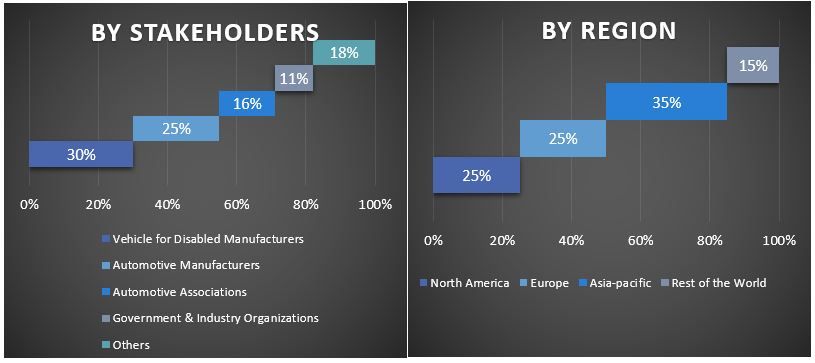
Market Engineering
The data triangulation technique was employed to complete the overall market estimation and to arrive at precise statistical numbers for each segment and sub-segment of the Global Vehicle for Disabled market. Data was split into several segments and sub-segments after studying various parameters and trends by Vehicle Type, Manufacturer Type, and by Driving Option in the Global Vehicle for Disabled market.
The main objective of the Global Vehicle for Disabled Market Study
The current & future market trends of the Global Vehicle for Disabled market were pinpointed in the study. Investors can gain strategic insights to base their discretion for investments on the qualitative and quantitative analysis performed in the study. Current and future market trends determined the overall attractiveness of the market at a regional level, providing a platform for the industrial participant to exploit the untapped market to benefit from a first-mover advantage. Other quantitative goals of the studies include:
- Analyze the current and forecast market size of the Global Vehicle for Disabled market in terms of value (USD). Also, analyze the current and forecast market size of different segments and sub-segments.
- Segments in the study include areas by Vehicle Type, Manufacturer Type, and by Driving Option.
- Define and analyze the regulatory framework for global Vehicle for Disabled industry.
- Analyze the value chain involved with the presence of various intermediaries, along with analyzing customer and competitor behaviors of the industry.
- Analyze the current and forecast market size of the Global Vehicle for Disabled market for the major regions.
- Major countries of regions studied in the report include North America (The US, Canada, and Rest of North America), Europe (The UK, France, Germany, Italy, Spain, Rest of Europe), Asia-pacific (China, Japan, India, Rest of the Asia-pacific), Rest of the World
- Company profiles of the Global Vehicle for Disabled market and the growth strategies adopted by the market players to sustain in the fast-growing market.
- Deep dive regional level analysis of the industry
Related Reports
Customers who bought this item also bought










